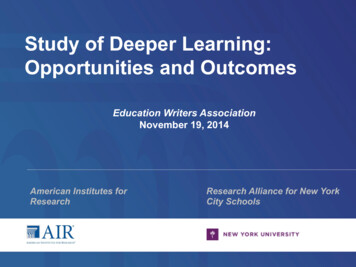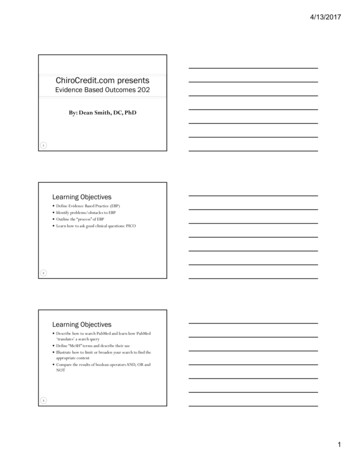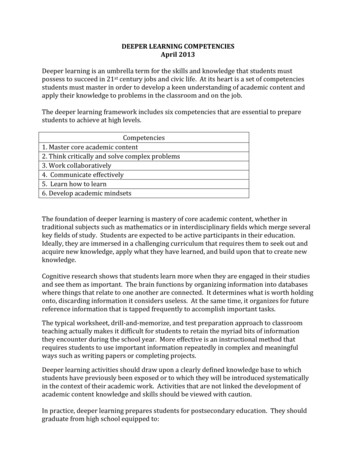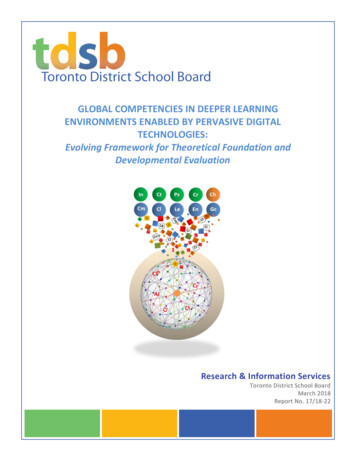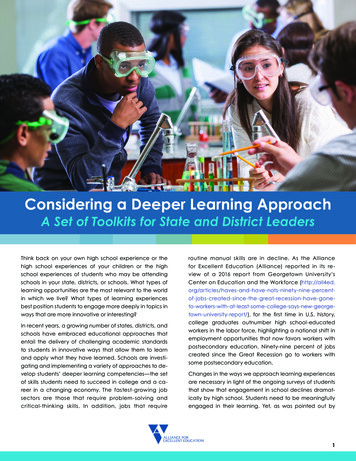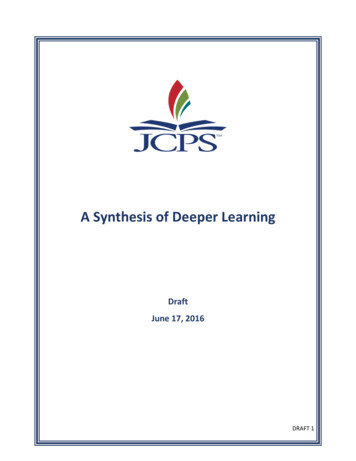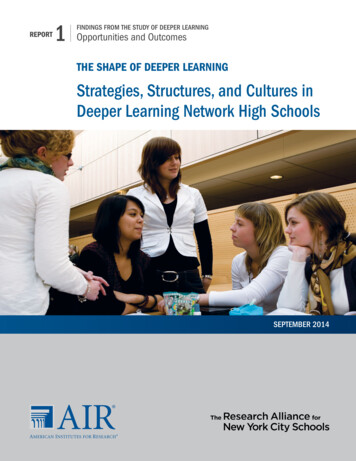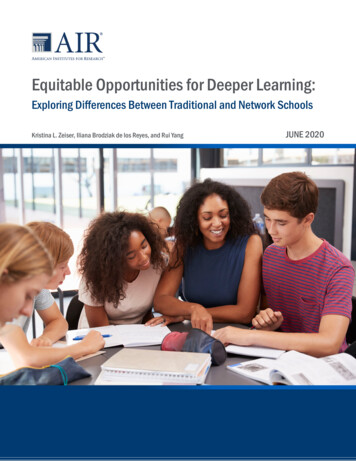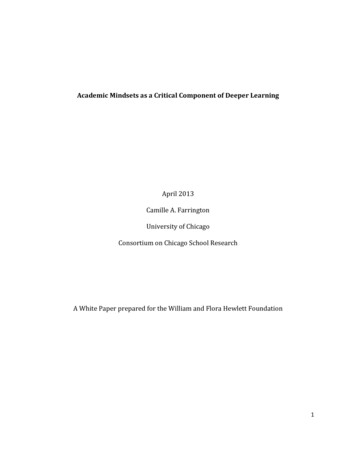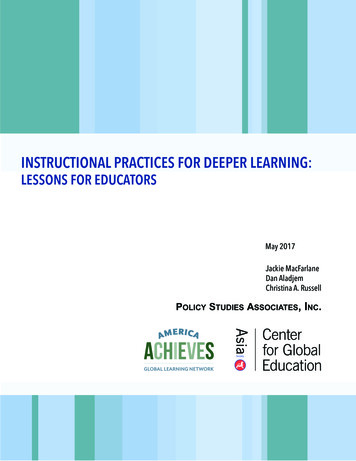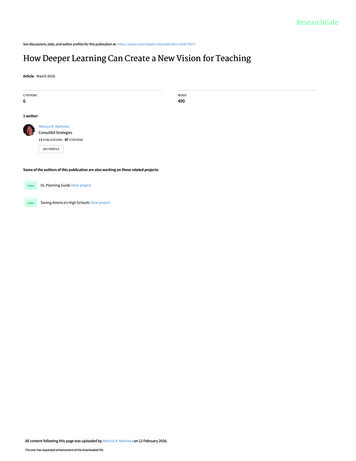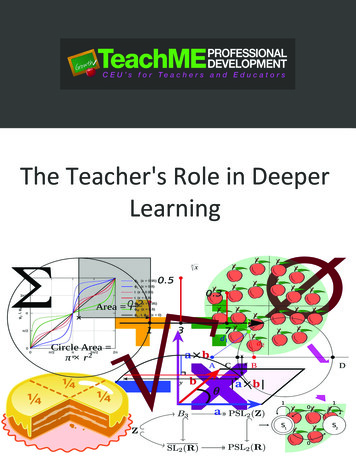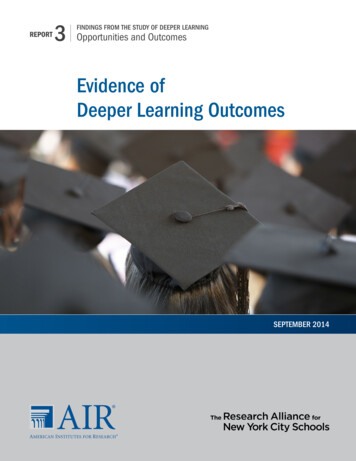
Transcription
REPORT3FINDINGS FROM THE STUDY OF DEEPER LEARNINGOpportunities and OutcomesEvidence ofDeeper Learning OutcomesSEPTEMBER 2014
AcknowledgmentsThe authors would like to acknowledge themany people who helped make this studypossible. We thank the thousands of students,teachers, principals, and network and districtstaff who agreed to provide responses to thestudy’s many data collections. We extend ourappreciation to the William and Flora HewlettFoundation for the grant that made this studypossible, and particularly to Kristi Kimball forher initiation of the project and Marc Chunand Barbara Chow for their consistent supportof this study. Our thanks also go to ElizabethStuart at Johns Hopkins University and LukeKeele at AIR and Pennsylvania State Universityfor technical advice, Kerstin Carlson LeFloch andLaura Salganik at AIR for their careful technicalreview, and Emma Ruckley for her thoroughediting. We are also grateful to Jim Kemple andthe staff at the Research Alliance for New YorkCity Schools for their expert analysis in thiscollaboration. The statements, findings, andconclusions here are those of the authors andstudy leads and do not necessarily represent theviewpoint of these organizations or individuals.Funded byThe William and Flora Hewlett FoundationNote: The content of this report is identical tothe original report released in September 2014.Only the report design has been modified.
REPORT 3FINDINGS FROM THE STUDY OF DEEPER LEARNINGOpportunities and OutcomesEvidence ofDeeper Learning OutcomesSEPTEMBER 2014AuthorsKristina L. Zeiser, James Taylor, Jordan Rickles, Michael S. GaretAmerican Institutes for ResearchMichael SegeritzResearch Alliance for New York City SchoolsPrincipal InvestigatorsJennifer O’Day, American Institutes for ResearchMichael S. Garet, American Institutes for ResearchStudy TeamCatherine BitterMegan BrownSeth BrownMarjorie ChinenMarian EatonMette HubermanJamie ShkolnikAllison WatersTara ZuberMolly AlterJames Kemple
ContentsAbstract . . . . . . . . . . . . . . . . . . . . . . . . . . . . . . . . . . . . . . . . . . . . . . . . . . . . . . . . . . . . . . . . viIntroduction . . . . . . . . . . . . . . . . . . . . . . . . . . . . . . . . . . . . . . . . . . . . . . . . . . . . . . . . . . . . . .1Study Design .Key Findings . . . . . . . . . . . . . . . . . . . . . . . . . . . . . . . . . . . . . . . . . . . . . . . . . . . . . . . . . . . . .12Cognitive Competency Outcomes . . . . . . . . . . . . . . . . . . . . . . . . . . . . . . . . . . . . . . . . . . .Did Students Who Attended the Network High Schools Score Higher on theOECD PISA-Based Test for Schools (PBTS) Than Students Who Attended theNon-Network Schools? . . . . . . . . . . . . . . . . . . . . . . . . . . . . . . . . . . . . . . . . . . . . . . . .Did Students Attending the Network High Schools Score Higher on StateAchievement Tests Than Students in the Non-Network Schools? . . . . . . . . . . . . . . . . . .Did the Effects on Students’ Cognitive Outcomes Differ Across Network Schools? . . . . .Did the Effects on Students’ Cognitive Outcomes Differ for Student Subgroups? . . . . . .Interpersonal and Intrapersonal Competency Outcomes . . . . . . . . . . . . . . . . . . . . . . . . . . .Did Students in the Network High Schools Report Higher Levels of Interpersonaland Intrapersonal Competencies Than Students in the Non-Network Schools? . . . . . . . .Did the Effects on Students’ Interpersonal and Intrapersonal OutcomesDiffer Across Network Schools? . . . . . . . . . . . . . . . . . . . . . . . . . . . . . . . . . . . . . . . . .Did the Effects on Students’ Interpersonal and Intrapersonal Outcomes Differfor Student Subgroups? . . . . . . . . . . . . . . . . . . . . . . . . . . . . . . . . . . . . . . . . . . . . . . .High School Graduation Outcomes . . . . . . . . . . . . . . . . . . . . . . . . . . . . . . . . . . . . . . . . . .Were Students Who Attended Participating Network High Schools More Likelyto Graduate On Time Than Students in Non-Network Schools? . . . . . . . . . . . . . . . . . . .Did the Effects on Students’ On-time Graduation Differ Across Network Schoolsor for Student Subgroups? . . . . . . . . . . . . . . . . . . . . . . . . . . . . . . . . . . . . . . . . . . . . .Postsecondary Attainment Outcomes . . . . . . . . . . . . . . . . . . . . . . . . . . . . . . . . . . . . . . . .Were Students Who Attended Participating Network High Schools More Likelyto Enroll or Persist in College Than Students in the Non-Network High Schools? . . . . . . .Did the Effects on Students’ Postsecondary Outcomes Differ Across NetworkSchools or for Student Subgroups? . . . . . . . . . . . . . . . . . . . . . . . . . . . . . . . . . . . . . . .Key Takeaways . . . . . . . . . . . . . . . . . . . . . . . . . . . . . . . . . . . . . . . . . . . . . . . . . . . . . . . . . . .26References . . . . . . . . . . . . . . . . . . . . . . . . . . . . . . . . . . . . . . . . . . . . . . . . . . . . . . . . . . . . . .29
AbstractThe Study of Deeper Learning: Opportunities and Outcomes—funded by the William and Flora Hewlett Foundation—aimed to determinewhether students attending high schools with a mature and at least moderately well implemented approach to promoting deeperlearning actually experienced greater deeper learning opportunities and outcomes than they would have had they not attended theseschools. In this report—our third in a series of three—we focus specifically on key questions about student outcomes: Did students whoattended participating network high schools perform better on tests of cognitive competency, report higher levels of interpersonal andintrapersonal competencies, or attain higher rates of high school graduation and college enrollment than they would have had they notattended the network schools?The analyses in this report focus on students from between 10 and 13 pairs of matched deeper learning network and comparisonschools in California and New York (the number of pairs included in specific analyses varied based on the availability of data). Afterstatistically accounting for differences in student background characteristics, we found that students who attended participating networkhigh schools that explicitly focused on deeper learning experienced superior outcomes compared to students who attended non-networkcomparison high schools. Key takeaways include the following:1. On average, students who attended the network schools in the study achieved higher scores on the OECD PISA-Based Test forSchools (PBTS)—a test that assesses core content knowledge and complex problem-solving skills—than did similar studentswho attended non-network high schools. Students who attended network schools scored higher on all three PBTS subjectstested (reading, mathematics, and science). They also earned higher scores on the state English Language Arts (ELA) andmathematics tests.2. Students who attended participating network schools reported more positive interpersonal and intrapersonal outcomesthan students who attended non-network schools. In particular, they reported higher levels of collaboration skills, academicengagement, motivation to learn, and self-efficacy. There were no significant differences between students who attended networkand non-network schools on reported creative thinking skills, perseverance, locus of control, or self-management.3. Students who attended participating network schools were more likely to graduate from high school on time (within four yearsof entering Grade 9) than were students who attended non-network high schools. The graduation rate among students whoattended network schools was estimated to be about 9 percentage points higher than among similar students who attendednon-network schools.4. Students who attended participating network schools and non-network schools had similar rates of enrollment in postsecondaryinstitutions overall. However, students who attended network schools were more likely to enroll in four-year institutions and inselective institutions.5. Although there were significant positive effects of attending a network school averaging across the pairs of network andnon-network schools in our sample, for many outcomes—for example, PBTS mathematics scores—the effects of attendinga network school varied significantly across individual pairs of schools.Attending a network school had similar benefits for students who entered high school with low achievement and those who enteredwith high achievement, particularly for the test score and high school graduation outcomes. However, while attending a network schoolincreased the postsecondary enrollment rate of students who entered high school with low achievement, it had no effect on thepostsecondary enrollment rate of students who entered with high achievement.viREPORT 3 FINDINGS FROM THE STUDY OF DEEPER LEARNING Opportunities and Outcomes
IntroductionThe world high school students face today is very different from the world experienced by previousgenerations. With the rapid evolution of technology, the global expansion of jobs and businesses,and an increasingly complex and diverse democracy, new graduates must navigate an environmentthat is rapidly and continually changing. Despite decades of educational reform efforts, concernspersist that too few American students acquire the knowledge and skills required to becomeengaged and productive citizens of this changing world (Murnane & Levy, 1996; Levy & Murnane,2013). These concerns are more pronounced in schools that serve disproportionate numbers ofstudents of color and students living in poverty. In response, a movement in support of “deeperlearning” has emerged among researchers, policymakers, and practitioners in an effort to improvestudents’ future success in college and in their careers and civic life.The concept of deeper learning has been used both to describe a set of competencies or goals forstudents and to characterize a way of learning (or a process) that promotes these competencies.The William and Flora Hewlett Foundation—a leader in the national initiative to promote deeperlearning in schools—has defined deeper learning as “a set of competencies students mustmaster in order to develop a keen understanding of academic content and apply their knowledgeto problems in the classroom and on the job” (William and Flora Hewlett Foundation, 2013, p. 1).In this view, deeper learning focuses on the development of six interconnected competencies thatmany argue are prerequisites for success in college, career, and civic life: Mastery of core academic content Critical thinking and complex problem-solving skills Effective communication skills Collaboration skills An understanding of how to learn Academic mindsets (William and Flora Hewlett Foundation, 2013; Chow, 2010; Trilling, 2010).Taking a slightly different approach, a recent review of theory and research across an array ofdisciplines led a National Research Council panel (National Research Council [NRC], 2012) todefine deeper learning as “the process through which an individual becomes capable of takingwhat was learned in one situation and applying it to new situations (i.e., transfer).” The paneldistinguished that process from the specific “21st century competencies” it produces. The NRCgrouped these competencies into three domains: the cognitive domain, the interpersonal domain,and the intrapersonal domain. These domains neatly subsume the six dimensions identifiedby the Hewlett Foundation, providing a compatible framework for the purposes of both researchand practice.1Evidence of Deeper Learning Outcomes
Proponents of deeper learning argue that core content knowledge is insufficient without broaderthinking and application skills. Sutherland, Shin, and Krajcik (2010), for example, state:“It is not enough for students only to understand big ideas; in fact, they cannot develop integratedunderstandings of even these core ideas unless they use their knowledge in meaningful ways,applying what they know to a variety of contexts and to novel situations” (p. 4). Further, proponentsargue that exposure to instruction focused on deeper learning prepares students to be successfulprofessionals, thinkers, and citizens in their adult lives (Finegold & Notabartolo, 2010). Specifically,they argue that supporting students to acquire both academic content knowledge and the skillsrequired to critically deploy this knowledge facilitates the development of “competencies thatenable graduating high school students to be college and career ready and then make maximumuse of their knowledge in life and work” (Alliance for Excellent Education, 2010, p. 1).Unfortunately, the research on deeper learning has lagged behind the political and educationalinterest in this concept and the activity of practitioners in schools and districts. In particular, thereis an absence of empirical research that evaluates whether instruction focused on deeper learningaffects students’ educational experiences and outcomes (NRC, 2012).1 Although early evaluationstudies of schools participating in networks focused on deeper learning suggested positive effects,the studies had a number of limitations relating to their research designs, samples, data, measures,and/or analyses (Yuan & Le, 2010). More recent evaluations (Collins et al., 2013; Guha et al.,2014; Nichols-Barrer & Haimson, 2013) have also suggested positive program effects onindicators such as grade point average (GPA), progress to graduation, and state test results,but these studies are primarily descriptive in nature or have focused on demonstrating theeffectiveness of specific instructional programs or approaches aligned with the goals of deeperlearning. Indeed, a recent NRC panel noted the limitations of existing (primarily correlational)research in establishing linkages between deeper learning competencies and long-term outcomesfor students and recommended that foundations and federal agencies support further research inthis arena (NRC, 2012). As a result of this limited empirical base, there has recently been increasedinterest in rigorous research that evaluates whether school approaches explicitly focused ondeveloping deeper learning competencies are associated with improved educational experiencesand outcomes for students from all backgrounds.The Study of Deeper Learning: Opportunities and Outcomes—funded by the Hewlett Foundation—aimed to determine whether students who attended high schools with a mature and at leastmoderately well implemented approach to promoting deeper learning actually experienced greater1Emerging research suggests that exposure to instruction focused on deeper learning correlates with increased academicachievement, leading to a more flexible and competent relationship with knowledge (Darling-Hammond, 2011; Alexander,Dinsmore, Grossnickle, List, Loughlin, & Parkinson, 2010; Finegold & Notabartolo, 2010; Sutherland, Shin, & Krajcik, 2010;Wickersham & McGee, 2008). Most recently, researchers at the Educational Policy Improvement Center (Collins et al., 2013)examined the impacts of a curriculum intended to promote “deeper learning”—the Roadtrip Nation Experience (RTN)—andfound increases in the GPA of RTN students compared to their peers. However, all of these studies note limitations or lackmethodological documentation.2REPORT 3 FINDINGS FROM THE STUDY OF DEEPER LEARNING Opportunities and Outcomes
deeper learning opportunities and outcomes than likely would have been the case had they notattended these schools.2 In contrast to an evaluation of a particular program or approach todeeper learning, this proof-of-concept study focused on providing evidence to indicate whetherschools can promote deeper learning across a variety of reasonably well implemented approachesand a diversity of students. This study aimed to address the evidence gap related to deeper learningby using a rigorous quasi-experimental design3 to examine a set of high schools (hereafter referredto as “network” schools) associated with ten established networks from across the country thatembrace the goals of deeper learning, promote instructional practices they believe are likely tolead to deeper learning competencies, and participate in the Hewlett Foundation’s Deeper LearningCommunity of Practice. (See Box 1 for a list of participating networks.) As described in the firstreport in this series, The Shape of Deeper Learning: Strategies, Structures, and Cultures in DeeperLearning Network High Schools (Huberman, Bitter, Anthony, & O’Day, 2014), the network schoolsincluded in this study shared an explicit, school-wide focus on deeper learning as a goal forstudents. While employing a diverse range of approaches to promote deeper learning, theyhad several strategies and structures in common.Box 1: Networks Participating in the Hewlett Foundation’s Deeper Learning Community of PracticeAsia Society – ls-networkBig Picture Learning – http://www.bigpicture.org/ConnectEd – http://www.connectedcalifornia.org/EdVisions Schools – http://www.edvisions.com/Envision Schools – http://www.envisionschools.org/Expeditionary Learning – http://elschools.org/High Tech High – http://www.hightechhigh.org/Internationals Network for Public Schools – http://internationalsnps.org/New Tech Network – http://www.newtechnetwork.org/New Visions for Public Schools – http://www.newvisions.org/Note: See our first report (Huberman et al., 2014) for more information on the Deeper Learning Community of Practice.23See our first report (Huberman et al., 2014) for a description of the approaches to promoting deeper learning taken by schoolsin this study.A quasi-experimental design estimates the effect of a “treatment,” program, or intervention by comparing outcomes for peoplewho chose or were selected to participate and those who did not, rather than by randomly assigning participants (see Shadish,Cook, & Campbell, 2002).3Evidence of Deeper Learning Outcomes
The Hewlett Foundation’s deeper learning initiative reflects a set of core assumptions about howa school’s approach to promoting deeper learning can result in improved outcomes for students,including postsecondary success and civic and employment outcomes. In this study, we examinedthe underlying premise of this initiative: that explicit strategies, structures, and school culturedesigned to support deeper learning would result in students experiencing greater opportunitiesto engage in deeper learning. These opportunities would, in turn, lead to transferable knowledgeand skills—or competencies—that are critical to readiness for college, career, and civic life.For analysis and interpretation, we group these competencies into three overlapping domains,as defined by the National Research Council (2012): the cognitive domain, including mastery ofacademic content knowledge and complex problem solving; the interpersonal domain, includingcollaboration and communication skills; and the intrapersonal domain, including an understandingof how to learn and academic mindsets such as motivation to learn, academic engagement, andself-efficacy (Farrington et al., 2012; Soland, Hamilton, & Stecher, 2013; NRC, 2012). Proponentsof deeper learning argue that approaches focused on developing these competencies can improveoutcomes for all students, including those from traditionally underserved groups and those whohave not previously experienced educational success. The abbreviated theory of action for thedeeper learning initiative (shown in Exhibit 1) delineates the key hypothesized relationshipsbetween school approaches to promoting deeper learning, opportunities to enga
learning in schools—has defined deeper learning as “a set of competencies students must master in order to develop a keen understanding of academic content and apply their knowledge to problems in the classroom and on the
